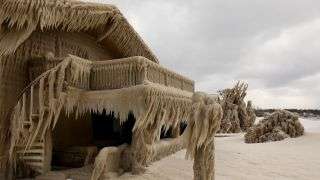
Ice formed on a house during a storm in Hamburg, New York, on Feb. 28.
Winter’s chill recently turned Lake Erie into “Lake Eerie,” as frigid temperatures transformed a trio of lakeside houses in Hamburg, New York, into unsettling ice sculptures. The frigid cold and wind sealed the homes inside thick layers of solid ice, topped with still more frozen layers of wavy icicle “hair.”
Beginning on Feb. 27 and continuing for 48 hours, winds gusted over Lake Erie at speeds up to 60 mph (97 km/h), driving lake water inland to the Hoover Beach neighborhood, AccuWeather reported.
There, freezing temperatures solidified the water wherever it was carried by the wind, forming an icy coating on several homes — and the ice just kept building up, according to The Weather Channel.
Around this time of year, ice cover is usually abundant on Lake Erie’s surface. That typically prevents the shoreline from being soaked with cold water during powerful storms; however, Lake Erie’s eastern end is nearly ice-free this year, leaving the shore vulnerable to spray from storm-whipped waves, The Weather Channel reported.
Ice blanketing the homes was estimated to be around 3 feet (1 meter) thick and was so solid that it even blocked daylight coming through the windows, Hoover Beach resident Ed Mis told CNN.
“It’s dark on the inside of my house,” Mis said. “It looks fake, it looks unreal.” The neighborhood had experienced some ice coatings like this before, but this event was the most extreme in nearly a decade, Mis told CNN.
“Welcome to Narnia,” wrote John Kucko, a TV anchor in Rochester, New York. On Feb. 29, Kucko tweeted a photo showing the frozen houses.
Welcome to Narnia: Two days of gale force winds along Lake Erie have iced over many of the homes along the beach in Hamburg, NY. @news4buffalo @News_8 @EricSnitilWx @JamesGilbertWX @wnywxguy @spann @JimCantore @StephanieAbrams @StormHour @NatalieKucko pic.twitter.com/uMvIdVWMGzFebruary 29, 2020
Kucko later tweeted another photo revealing why the three houses froze while their nearest neighbors didn’t. The frozen homes lacked a buffer zone of boulders on the beach in front of them; the big piles of rock broke up the waves’ momentum and reduced the amount of water spray from high winds to those other homes, Kucko said.
OFFER: Save at least 53% with our latest magazine deal!
With impressive cutaway illustrations that show how things function, and mindblowing photography of the world’s most inspiring spectacles, How It Works represents the pinnacle of engaging, factual fun for a mainstream audience keen to keep up with the latest tech and the most impressive phenomena on the planet and beyond. Written and presented in a style that makes even the most complex subjects interesting and easy to understand, How It Works is enjoyed by readers of all ages.
View Deal
Sourse: www.livescience.com





